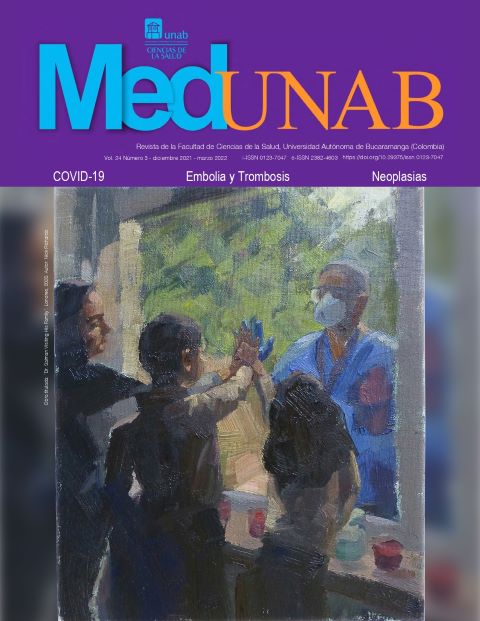Nueva clasificación molecular del carcinoma de endometrio: impacto en el diagnóstico histopatológico, tratamiento y pronóstico
Resumen
Introducción. El carcinoma de endometrio es una patología heterogénea a nivel patogénico, histopatológico y molecular. En los últimos años se han sumado esfuerzos para esclarecer y aumentar el conocimiento de las bases moleculares, logrando así dividir las pacientes en cuatro subgrupos descritos por el Atlas del Genoma del Cáncer (TCGA, por sus siglas en inglés), obteniéndose valiosa información que afecta el diagnóstico, tratamiento y pronóstico de las pacientes con esta enfermedad. El objetivo de la siguiente revisión es exponer la nueva clasificación molecular del carcinoma de endometrio, así como discutir las ventajas que esta trae a la hora de estratificar a las pacientes y tomar decisiones terapéuticas. División de los temas tratados. Se realizó una búsqueda bibliográfica no sistemática en las bases de datos PubMed, Cochrane y Medline desde el año 2014 hasta el 2020 sobre el carcinoma de endometrio y su clasificación molecular. Se expone de manera concreta y actualizada el contexto histórico, los diferentes subgrupos moleculares y cómo estos impactan en el manejo de las pacientes. Conclusiones. El carcinoma de endometrio es una enfermedad heterogénea a nivel histopatológico, clínico y molecular. Con la nueva clasificación y los estudios prospectivos se podrán crear nuevas estrategias que permitan brindar mejores protocolos diagnósticos y terapéuticos.
Referencias bibliográficas
Talhouk A, McAlpine JN. New classification of endometrial cancers: the development and potential applications of genomic-based classification in research and clinical care. Gynecol Oncol Res Pract [Internet]. 2016;3:14. doi: https://doi.org/10.1186/s40661-016-0035-4
Zhang Y, Liu H, Yang S, Zhang J, Qian L, Chen X. Overweight, Obesity and Endometrial Cancer Risk: Results from a Systematic Review and Meta-Analysis. Int J Biol Markers [Internet]. 2014;29(1):e21–9. doi: https://doi.org/10.5301/JBM.5000047
Pardo C, Cendales R. Incidencia, mortalidad y prevalencia de cáncer en Colombia, 2007-2011, Primera edición. Bogotá. D.C. Instituto Nacional de Cancerología, 2015, v.1. p. 148.
Sung H, Ferlay J, Siegel RL, Laversanne M, Soerjomataram I, Jemal A, et al. Global Cancer Statistics 2020: GLOBOCAN Estimates of Incidence and Mortality Worldwide for 36 cancers in 185 Countries. CA Cancer J Clin [Internet]. 2021;(caac.21660). doi: https://doi.org/10.3322/caac.21660
Morice P, Leary A, Creutzberg C, Abu-Rustum N, Darai E. Endometrial cancer. Lancet [Internet]. 2016;387(10023):1094-108. doi: https://doi.org/10.1016/S0140-6736(15)00130-0
Del Carmen MG, Boruta DM, Schorge JO. Recurrent Endometrial Cancer. Clin Obstet Gynecol [Internet]. 2011 Jun; 54 (2):266-77. doi: https://doi.org/10.1097/GRF.0b013e318218c6d1
Jung KW, Won YJ, Kong HJ, Oh CM, Lee DH, Lee JS. Prediction of cancer incidence and mortality in Korea, 2014. Cancer Res Treat [Internet]. 2014;46(2):124-30. doi: https://doi.org/10.4143/crt.2014.46.2.124
Bokhman JV. Two pathogenetic types of endometrial carcinoma. Gynecol Oncol [Internet]. 1983;15(1):10-7. doi: https://doi.org/10.1016/0090-8258(83)90111-7
Abdulfatah E, Wakeling E, Sakr S, Al-Obaidy K, Bandyopadhyay S, Morris R, et al. Molecular classification of endometrial carcinoma applied to endometrial biopsy specimens: Towards early personalized patient management. Gynecol Oncol [Internet]. 2019;154(3):467-474. doi: https://doi.org/10.1016/j.ygyno.2019.06.012
World Health Organization. Publication of the WHO Classification of Tumours, 5th Edition, Vo|lume 4: Female genital Tumours [Internet]. Who.int. [consultado el 27 de abril de 2021]. Recuperado a partir de https://www.iarc.who.int/news-events/publication-of-the-who-classification-of-tumours-5th-edition-volume-4-female-genital-tumours/
Murali R, Davidson B, Fadare O, Carlson JA, Crum CP, Gilks CB, et al. High-grade Endometrial Carcinomas: Morphologic and Immunohistochemical Features, Diagnostic Challenges and Recommendations. Int J Gynecol Pathol [Internet]. 2019;38:S40-S63. doi: https://doi.org/10.1097/PGP.0000000000000491
Han G, Soslow RA, Wethington S, Levine DA, Bogomolniy F, Clement PB, et al. Endometrial Carcinomas With Clear Cells: A Study of a Heterogeneous Group of Tumors Including Interobserver Variability, Mutation Analysis, and Immunohistochemistry with HNF-1β. Int J Gynecol Pathol [Internet]. 2015;34(4):323-33. doi: https://doi.org/10.1097/PGP.0000000000000162
Mhlongo SE, Naidoo TD, Makhathini BS. Discrepancy between preoperative endometrial sampling and hysterectomy diagnosis in endometrial cancer. South Afr J Gynaecol Oncol [Internet]. 2020;12(1):13-6. doi: https://doi.org/10.1080/20742835.2020.1754659
Imai K, Kato H, Katayama K, Nakanishi K, Kawano A, Iura A, et al. A preoperative risk-scoring system to predict lymph node metastasis in endometrial cancer and stratify patients for lymphadenectomy. Gynecol Oncol [Internet]. 2016;142(2):273-7. doi: https://doi.org/10.1016/j.ygyno.2016.06.004
Bendifallah S, Canlorbe G, Collinet P, Arsène E, Huguet F, Coutant C, et al. Just how accurate are the major risk stratification systems for early-stage endometrial cancer? Br J Cancer [Internet]. 2015;112(5):793-801. doi: https://doi.org/10.1038/bjc.2015.35
McConechy MK, Talhouk A, Leung S, Chiu D, Yang W, Senz J, et al. Endometrial carcinomas with POLE Exonuclease Domain Mutations Have a Favorable Prognosis. Clin Cancer Res [Internet]. 2016;22(12):2865-73. doi: https://doi.org/10.1158/1078-0432.ccr-15-2233
Levine DA, The Cancer Genome Atlas Research Network. Integrated genomic characterization of endometrial carcinoma. Nature [Internet]. 2013;497(7447):67-73. doi: https://doi.org/10.1038/nature12113
McAlpine J, Leon-Castillo A, Bosse T. The rise of a novel classification system for endometrial carcinoma; integration of molecular subclasses. J Pathol [Internet]. 2018;244:538-549. doi: https://doi.org/10.1002/path.5034
Rayner E, van Gool IC, Palles C, Kearsey SE, Bosse T, Tomlinson I, et al. A panoply of errors: polymerase proofreading domain mutations in cancer. Nat Rev Cancer [Internet]. 2016;16:71-81. doi: https://doi.org/10.1038/nrc.2015.12
Talhouk A, McConechy MK, Leung S, Li-Chang HH, Kwon JS, Melnyk N, et al. A clinically applicable molecular-based classification for endometrial cancers. Br J Cancer [Internet]. 2015;113: 299-310. doi: https://doi.org/10.1038/bjc.2015.190
Shinbrot E, Henninger EE, Weinhold N, Covington KR, Göksenin AY, Schultz N, et al. Exonuclease mutations in DNA polymerase epsilon reveal replication strand specific mutation patterns and human origins of replication. Genome Res [Internet]. 2014;24:1740-50. doi: https://doi.org/10.1101/gr.174789.114
Eggink FA, Van Gool IC, Leary A, Pollock PM, Crosbie EJ, Mileshkin L, et al. Immunological profiling of molecularly classified high-risk endometrial cancers identifies POLE-mutant and microsatellite unstable carcinomas as candidates for checkpoint inhibition. Oncoimmunology [Internet]. 2017;6(2):e1264565. doi: https://doi.org/10.1080/2162402X.2016.1264565
Hussein YR, Weigelt B, Levine DA, Schoolmeester JK, Dao LN, Balzer BL, et al. Clinicopathological analysis of endometrial carcinomas harboring somatic POLE exonuclease domain mutations. Mod Pathol [Internet]. 2015;28:505-14. doi: https://doi.org/10.1038/modpathol.2014.143
Simpkins SB, Bocker T, Swisher EM, Mutch DG, Gersell DJ, Kovatich AJ, et al. MLH1 Promoter Methylation and Gene Silencing is the Primary Cause of Microsatellite Instability in Sporadic Endometrial Cancers. Hum Mol Genet [Internet]. 1999;8(4):661-666. doi: https://doi.org/10.1093/hmg/8.4.661
Liccardo R, De Rosa M, Izzo P, Duraturo F. Novel Implications in Molecular Diagnosis of Lynch Syndrome. Gastroenterol Res Pract [Internet]. 2017;2017:12p. doi: https://doi.org/10.1155/2017/2595098
DeLair DF, Burke KA, Selenica P, Lim RS, Scott SN, Middha S, et al. The genetic landscape of endometrial clear cell carcinomas. J Pathol [Internet]. 2017;243(2):230-241. doi: https://doi.org/10.1002/path.4947
Stelloo E, Nout RA, Osse EM, Jürgenliemk-Schulz IJ, Jobsen JJ, Lutgens LC, et al. Improved Risk Assessment by Integrating Molecular and Clinicopathological Factors in Early-stage Endometrial Cancer-Combined Analysis of the PORTEC Cohorts. Clin Cancer Res [Internet]. 2016;22(16):4215-24. doi: https://doi.org/10.1158/1078-0432.CCR-15-2878
Visser NC, Bulten J, van der Wurff AA, Boss EA, Bronkhorst CM, Feijen HW, et al. PIpelle Prospective ENDOmetrial carcinoma (PIPENDO) study, pre-operative recognition of high risk endometrial carcinoma: a multicentre prospective cohort study. BMC Cancer [Internet]. 2015;15:487. doi: https://doi.org/10.1186/s12885-015-1487-3
Carlson J, McCluggage WG. Reclassifying endometrial carcinomas with a combined morphological and molecular approach. Curr Opin Oncol [Internet]. 2019;31(5):411-419. doi: https://doi.org/10.1097/CCO.0000000000000560
Suarez AA, Felix AS, Cohn DE. Bokhman Redux: Endometrial cancer “types” in the 21st century. Gynecol Oncol [Internet]. 2017;144(2):243-249. doi: https://doi.org/10.1016/j.ygyno.2016.12.010
Alvarado-Cabrero I, Estevez-Castro R, Valencia-Cedillo R. Estado actual del carcinoma de endometrio. Patología Rev Latinoam [Internet]. 2020;58:1-9. Recuperado a partir de: http://www.revistapatologia.com/content/2020/0106201326.pdf
Bosse T, Nout RA, McAlpine JN, McConechy MK, Britton H, Hussein YR, et al. Molecular Classification of Grade 3 Endometrioid Endometrial Cancers Identifies Distinct Prognostic Subgroups. Am J Surg Pathol [Internet]. 2018;42(5):561-568. doi: https://doi.org/10.1097/PAS.0000000000001020
Cosgrove CM, Cohn DE, Hampel H, Frankel WL, Jones D, McElroy JP, et al. Epigenetic silencing of MLH1 in endometrial cancers is associated with larger tumor volume, increased rate of lymph node positivity and reduced recurrence-free survival. Gynecol Oncol [Internet]. 2017;146(3):588-595. doi: https://doi.org/10.1016/j.ygyno.2017.07.003
Hoang LN, Kinloch MA, Leo JM, Grondin K, Lee CH, Ewanowich C, et al. Interobserver Agreement in Endometrial Carcinoma Histotype Diagnosis Varies Depending on The Cancer Genome Atlas (TCGA)-based Molecular Subgroup. Am J Surg Pathol [Internet]. 2017;41(2):245-252. doi: https://doi.org/10.1097/PAS.0000000000000764
Talhouk A, McConechy MK, Leung S, Yang W, Lum A, Senz J, et al. Confirmation of ProMisE: A simple, genomics-based clinical classifier for endometrial cancer. Cancer [Internet]. 2017;123(5):802-813. doi: https://doi.org/10.1002/cncr.30496
Stelloo E, Bosse T, Nout RA, MacKay HJ, Church DN, Nijman HW, et al. Refining prognosis and identifying targetable pathways for high-risk endometrial cancer; a TransPORTEC initiative. Mod Pathol [Internet]. 2015;28:836-844. doi: https://doi.org/10.1038/modpathol.2015.43
Stelloo E, Nout RA, Osse EM, Jürgenliemk-Schulz IJ, Jobsen JJ, Lutgens LC, et al. Improved Risk Assessment by Integrating Molecular and Clinicopathological Factors in Early-stage Endometrial Cancer-Combined Analysis of the PORTEC Cohorts. Clin Cancer Res [Internet]. 2016;22(16):4215-24. doi: https://doi.org/10.1158/1078-0432.CCR-15-2878
Van Esterik M, Van Gool IC, de Kroon CD, Nout RA, Creutzberg CL, Smit VTHBM, et al. Limited impact of intratumour heterogeneity on molecular risk assignment in endometrial cancer. Oncotarget [Internet]. 2017;8:25542-51. doi: https://doi.org/10.18632/oncotarget.16067
Talhouk A, Hoang LN, McConechy MK, Nakonechny Q, Leo J, Cheng A, et al. Molecular classification of endometrial carcinoma on diagnostic specimens is highly concordant with final hysterectomy: Earlier prognostic information to guide treatment. Gynecol Oncol [Internet]. 2016;143(1):46-53. doi: https://doi.org/10.1016/j.ygyno.2016.07.090
ISRCTN registry.PORTEC‐4a: Randomised Trial of Standard or Molecular Profile‐Based Recommendation for Radiotherapy after Surgery for Women with Early Stage Endometrial Cancer. ISRCTN [Internet]. 2016. doi: https://doi.org/10.1186/ISRCTN11659025
Howitt BE, Shukla SA, Konstantinopoulos PA. Neoepitopes and CD3-Positive and CD8-Positive Cells in Polymerase e-Mutated and Microsatellite-Instable Endometrial Cancers--Reply. JAMA Oncol [Internet]. 2016;2(1):141-2. doi: https://doi.org/10.1001/jamaoncol.2015.3903
Brown SD, Warren RL, Gibb EA, Martin SD, Spinelli JJ, Nelson BH, et al. Neo-antigens predicted by tumor genome meta-analysis correlate with increased patient survival. Genome Res [Internet]. 2014;24:743-750. doi: https://doi.org/10.1101/gr.165985.113
Schumacher TN, Schreiber RD. Neoantigens in cancer immunotherapy. Science [Internet]. 2015;348(6230):69-74. doi: https://doi.org/10.1126/science.aaa4971
Sharpe AH, Pauken KE. The diverse functions of the PD1 inhibitory pathway. Nat Rev Immunol [Internet]. 2018;18:153-167. doi: https://doi.org/10.1038/nri.2017.108
Topalian SL, Drake CG, Pardoll DM. Immune Checkpoint Blockade: A Common Denominator Approach to Cancer Therapy. Cancer Cell [Internet]. 2015;27(4):450-61. doi: https://doi.org/10.1016/j.ccell.2015.03.001
Ott PA, Bang YJ, Berton-Rigaud D, Elez E, Pishvaian MJ, Rugo HS, et al. Safety and Antitumor Activity of Pembrolizumab in Advanced Programmed Death Ligand 1-Positive Endometrial Cancer: Results From the KEYNOTE-028 Study. J Clin Oncol [Internet]. 2017;35(22):2535-2541. doi: https://doi.org/10.1200/JCO.2017.72.5952
Mehnert JM, Panda A, Zhong H, Hirshfield K, Damare S, Lane K, et al. Immune activation and response to pembrolizumab in POLE-mutant endometrial cancer. J Clin Invest [Internet]. 2016;126(6):2334-40. doi: https://doi.org/10.1172/JCI84940
Santin AD, Bellone S, Buza N, Choi J, Schwartz PE, Schlessinger J, et al. Regression of Chemotherapy-Resistant Polymerase ε (POLE) Ultra-Mutated and MSH6 Hyper-Mutated Endometrial Tumors with Nivolumab. Clin Cancer Res [Internet]. 2016;22(23):5682-5687. doi: https://doi.org/10.1158/1078-0432.CCR-16-1031
Descargas
| Estadísticas de artículo | |
|---|---|
| Vistas de resúmenes | |
| Vistas de PDF | |
| Descargas de PDF | |
| Vistas de HTML | |
| Otras vistas | |






























